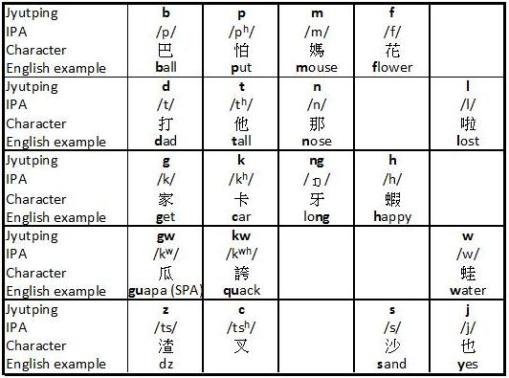Jyutping (Initials and Finals)
Useful content of Cantonese Romanization from another cantonese learning website : http://cantoneseeveryday.wordpress.com/2008/11/13/cantonese-romanization-system-jyutping-initials-and-finals/#comments
The basic units of Cantonese are Chinese characters while each character corresponds to one syllable. There are different kinds of Romanization for Cantonese but in this blog, the Romanization system Jyutping is adopted.
The Jyutping system is created by the Linguistics Society of Hong Kong and is used for denoting the sounds of standard Cantonese. The name Jyutping is a contraction of the first Chinese characters of the expression粵語 jyut6 jyu5 “Cantonese” and 拼音ping3 jam1 “phonetic alphabet”. The following shows the initials and the finals which compose the syllables in Cantonese:
Initials

Initial-Jyutping
Initial-Character

Final-Jyutping
Final-Character
The vowels are pronounced alone in the audio clip while the Chinese Characters are examples that contain those vowels but with different combination of initials.
The last three columns are finals that end with coda p, t and k. They all belong to entering tones in Cantonese. (Further detail shown in the part of ‘Tone’). Be careful when you are pronouncing these sounds because the distinction between them is actually quite subtle. As in International Phonetic Alphabet, p is a bilabial stop, t is an alveolar stop while k is a velar stop and they are all unreleased at the coda (final consonant) position in Cantonese.

Leave a Reply